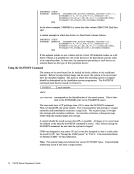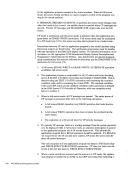Message Identification CP performs storage protection checking for all data moved during an lUCY com
munication.IUCV stores the source communicator's PSW key in the MSGBLOK. When the target communicator executes a RECEIVE or REPLY function, lUCY uses the PSW key for protection checking in the source virtual machine. lUCY uses the target communicator's PSW key at the time of the RECEIVE or REPLY to check data accesses in the target virtual machine.
A message is fully identified to a virtual machine by values that are recorded in theMSGBLOK. Message identification -a single fullword value that identifies a message. lUCY assigns a message id when the source communicator invokes the SEND
function. The message identification is generated by a sequential counter value
and is unique for the systemIPL. Message class -identifies the source message class and target message class.
The message classes are arbitrary fullword values that the source communica
tor specifies when invoking the SEND function. The meaning of the message
classes is agreed to in advance by the two communicators.lUCY places no
restrictions on the values specified for message class. The communicators can
use the message class to selectively dequeue messages.Path description and the target path description. lUCY assigns these path ids
when a path is established via theCONNECT and ACCEPT functions.
There is no defined relationship between the values of the source and target path
idslUCY assigns, or between the message classes the source and the target com
municators use. None of these values need be the same although they refer to the
same message.Only the message identification has the same value for both target
and source communicators.
Thus, when invokinglUCY functions, the source communicator refers to a mes
sage by a combination of its source path id, source message class, and message id.
The target communicator refers to the same message by a combination of its target
path id, target message class, and message id. When the target communicator
issues the DESCRIBE function,lUCY provides the target's identifiers.
In addition,lUCY provides another message identifier for the source communica
tor. When invoking the SEND function, the source communicator may specify a
message tag.lUCY does not assign a value or meaning to the tag; its use is deter
mined solely by the source communicator. For example, the source communicator
can use the message tag to tie a completed message to the original SEND request.lUCY presents the tag to the source communicator when the message completes.
Finally, a message can be identified as a priority message when the source commu
nicator invokes the SEND function.lUCY enqueues a priority message ahead of
any nonpriority messages on the target communicator's SEND queue and behind
any earlier priority messages. The installation must authorize a path to handle pri
ority messages in thelUCY directory control statement. Inter-User Communications Vehicle 113
munication.
A message is fully identified to a virtual machine by values that are recorded in the
function. The message identification is generated by a sequential counter value
and is unique for the system
The message classes are arbitrary fullword values that the source communica
tor specifies when invoking the SEND function. The meaning of the message
classes is agreed to in advance by the two communicators.
restrictions on the values specified for message class. The communicators can
use the message class to selectively dequeue messages.
when a path is established via the
There is no defined relationship between the values of the source and target path
ids
municators use. None of these values need be the same although they refer to the
same message.
and source communicators.
Thus, when invoking
sage by a combination of its source path id, source message class, and message id.
The target communicator refers to the same message by a combination of its target
path id, target message class, and message id. When the target communicator
issues the DESCRIBE function,
In addition,
tor. When invoking the SEND function, the source communicator may specify a
message tag.
mined solely by the source communicator. For example, the source communicator
can use the message tag to tie a completed message to the original SEND request.
Finally, a message can be identified as a priority message when the source commu
nicator invokes the SEND function.
any nonpriority messages on the target communicator's SEND queue and behind
any earlier priority messages. The installation must authorize a path to handle pri
ority messages in the



































































































































































































































































































































































































































































































































































































































